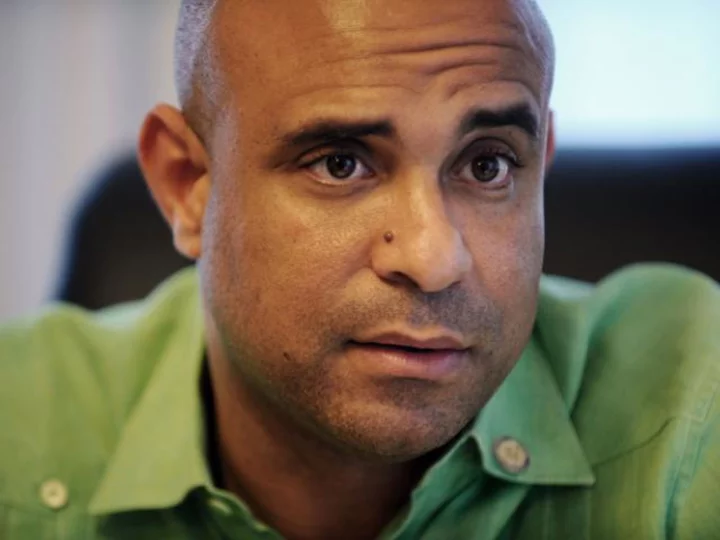
Lionel Messi set to be unveiled by Inter Miami and Major League Soccer
The stage is set
2023-07-17 00:07

Tropical Storm Bret grows stronger as eastern Caribbean islands prepare for heavy flooding
Tropical Storm Bret is growing stronger as it takes aim at islands in the eastern Caribbean that are bracing for torrential rainfall, landslides and flooding
2023-06-22 07:51

China, EU to hold high-level economic and trade dialogue in Beijing
BEIJING The 10th China-EU High-Level Economic and Trade Dialogue will be held in Beijing on Sept. 25, the
2023-09-21 15:13

Millions of kids are missing weeks of school as attendance tanks across the US
Nationwide, students have been absent at record rates since schools reopened after COVID-forced closures
2023-08-11 12:15

Jets know they must try to at least keep up with Patrick Mahomes and the Chiefs' explosive offense
The New York Jets acknowledge they’ll need to at least keep up with Patrick Mahomes and the Chiefs’ explosive offense Sunday night if they expect to have any chance of winning
2023-09-30 04:31

Kim Jong-un to hold weapons talks with Putin after ‘travelling to Russia in armoured train’
Kim Jong-un may be going to Russia this month to meet Vladimir Putin as Moscow tries to negotiate the possibility of receiving military equipment from North Korea for its Ukraine invasion. North Korea’s leader would travel from Pyongyang, probably by armoured train, to Vladivostok on the Pacific Coast of Russia, where he would meet Mr Putin, reported The New York Times. Both heads of state could be on the campus of Vladivostok’s Far Eastern Federal University to attend the Eastern Economic Forum, scheduled to take place from 10-13 September, according to the outlet. The date of travel or exact place of meeting, however, is not yet clear. Pyongyang is expected to ask Moscow to share their advanced technology for satellites and nuclear-powered submarines in exchange for weapons, reported NYT, citing officials on the condition of anonymity. The US has previously warned North Korea could supply more weapons to Russia, with US National Security Council spokesperson Adrienne Watson noting earlier on Monday that Russian defence minister Sergei Shoigu travelled to Pyongyang recently in a bid to persuade North Korea to sell artillery ammunition. “We have information that Kim Jong Un expects these discussions to continue, to include leader-level diplomatic engagement in Russia,” she said. She said the US is urging North Korea “to cease its arms negotiations with Russia and abide by the public commitments that Pyongyang has made to not provide or sell arms to Russia”. The White House said last week that it had intelligence indicating Mr Putin and Mr Kim swapped letters following Mr Shoigu’s visit. National Security Council spokesman John Kirby said the letters were “more at the surface level”, but that Russian and North Korean talks on a weapons sale were advancing. He also warned of sanctions against Pyongyang if it goes ahead with the weapons supply. Additional reporting by agencies Read More Ukraine-Russia war – live: Putin’s forces pushed back in the south as Moscow launches kamikaze drone attack Ukraine will need to be cunning – and patient – in its push to break through Russia’s defensive lines Pope insists Vatican-China relations are on track but says more work is needed
2023-09-05 12:22

Jess Glynne reveals she used to idolise Amy Winehouse
Jess Glynne used to idolise Amy Winehouse so had a "full cirlce" moment when she was able to perform at a pub the late music legend used to visit.
2023-10-26 15:00

NBA 2K23 Face Scan: Best Method
NBA 2K23 Face Scan: Best Method
1970-01-01 08:00

Taylor Swift fans can now get a job as a full time reporter on the singer
Attention Swifties... if you're looking to make your love for Taylor Swift a full-time job then you're in luck as USA Today and The USA Today Network’s newspaper The Tennessean are looking for a Taylor Swift reporter. No doubt the chosen candidate will be writing about Swift's career, the Eras tour and of course the Easter eggs the star loves to hide for her fans to find, as well as Swiftie conspiracy theories. In the role posted on September 12, the publication detailed why they are looking for a reporter to specifically focus on the global superstar. “Swift’s fanbase has grown to unprecedented heights, and so has the significance of her music and growing legacy. We are looking for an energetic writer, photographer and social media pro who can quench an undeniable thirst for all things Taylor Swift with a steady stream of content across multiple platforms," it read. It's been quite the year for Swift, who is the world's biggest artist with her record-breaking Eras Tour in North America, becoming the first woman to break 100 million monthly listeners on Spotify, as well as announcing she's releasing an Eras Tour concert film with AMC Theatres and smashing ticket sale records at $26 million. With all this in mind, the job description outlined what can be expected of the successful candidate. "Seeing both the facts and the fury, the Taylor Swift reporter will identify why the pop star’s influence only expands, what her fanbase stands for in pop culture, and the effect she has across the music and business worlds. "We are looking for a journalist with a voice — but not a bias — able to quickly cultivate a national audience through smart content designed to meet readers on their terms.” As the Eras Tour is set to resume in South America in November this year, followed by Asia, Australia and Europe next year, the reporter will be covering all the important moments from the live shows. This position is remote and can be based anywhere in the US, except for Alaska and Hawaii or based at our headquarters in McLean, VA, and international travel is also required in the role. In terms of qualifications, The USA Today Network wants somebody with a minimum of five years of journalism experience. Those interested in applying for the role will need to send a 1-2 page resume, a video cover letter explaining how they would approach the role, along with 4-8 samples of their work. Good luck Swifties! Sign up to our free Indy100 weekly newsletter Have your say in our news democracy. Click the upvote icon at the top of the page to help raise this article through the indy100 rankings.
2023-09-13 17:10

Liverpool GP suspended after changing records to cover error
Dr Victor Ebenuwa misdiagnosed a patient's condition and medication, a tribunal hears.
2023-09-18 19:47

Cubs rumors: Two trade targets identified as transition to buyer becomes real
The Chicago Cubs have officially become buyers rather than sellers in the MLB trade market, and their first two targets have become clear.The Chicago Cubs are in the midst of an eight-game winning streak and are creeping up the NL Central standings. With the wins has come every reason for the fr...
2023-07-31 04:30

Marketmind: Aussie rate decision, Asian markets on a roll
By Jamie McGeever A look at the day ahead in Asian markets from Jamie McGeever, financial markets columnist.
2023-09-05 05:47
You Might Like...

First Solar Breaks Ground on $1.1 Billion, 3.5 GW Louisiana Manufacturing Facility

'Two fabulous women!' Robin Roberts praised for her candid interview with Kerry Washington away from 'GMA'

School's out forever in ageing Japan

Liam Payne opens up about checking into secret 100-day rehab after controversial One Direction comments

A report that foreshadows CPI is a mix of good and bad

90min writers predict the 2023/24 Premier League table

FBI director faces GOP critics at hearing focused on Trump, Hunter Biden and more

State Department sanctions former Haitian Prime Minister Lamothe for corruption
